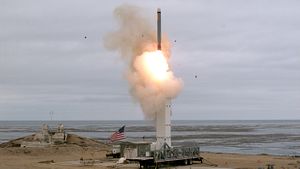In a move that may eventually have significant implications for the Indo-Pacific, on August 18 the United States tested a missile capable of breaching the limits established by the now defunct 1987 Intermediate-Range Nuclear Forces Treaty.
The test was conducted from a Vertical Launch System cell, identical to those deployed on U.S. Navy cruisers and destroyers. This is effectively the same technology used by the Aegis Ashore missile defense system that will soon be deployed in Japan, although Japan has thus far indicated no interest in using the system to host ground-launched cruise missiles (GLCM). The missile fired was a BGM-109 Tomahawk, likely the same as the Tomahawk missiles launched by U.S. Navy surface vessels. As Tyler Rogoway points out, the Tomahawks of today are considerably more lethal than their pre-INF cousins, the BGM-109G Gryphon. Modern Tomahawks have improved navigation and loiter capabilities, and can be retargeted in flight.
Critics of the discarding the treaty often argued that the United States had no systems capable of standing up in a useful timeframe. This and other tests suggest that the concern was overblown; the technology of 1981, generally speaking, is not terribly difficult to mimic or replicate in 2019. Somewhat more seriously, the test tends to support Russian claims that the United States was effectively cheating on the INF by deploying GLCM capable missile launchers in Poland and Romania. While the United States insisted, accurately, that those launchers were not equipped with the software necessary for GLCMs, Russia contested that they would require only modest modification. This test suggests how modest those modifications actually are, although as of yet there is no indication that the U.S. plans to deploy Tomahawks in Poland or Romania.
The INF was premised upon the idea that both the United States and Russia would refrain from developing and deploying, on land, systems that they could launch from both sea and air platforms. This was politically useful in 1987, but it was never tenable from a technological point of view. Anything that can be launched from an airplane or warship can, of course, be launched from a land platform, and generally speaking can be modified in fairly short order. GLCMs have different flight and launch profiles than air-launched or sea-launched cruise missiles, however, making them more threatening under certain conditions.
Thus far, no U.S. allies have agreed to the stationing of GLCMs on their territory, meaning that any missiles would currently be limited to Guam. The lack of allied buy in would, of course, make it difficult for the United States to actually mount what some have termed an “archipelagic defense” strategy. The United States does not have the sort of alliance structure in place in East Asia that enabled it to deploy GLCMs to recalcitrant states in Europe in the 1980s. Moreover, issues of sovereignty are more complex in East Asia than in Europe. Still, the willingness of East Asian states to host missiles depends on their assessment of the threat from China. Indeed, the fact that Japan will very shortly host launchers capable, with minimal modification, of launching GLCMs makes clear that the United States is likely to have basing options in the future.
































